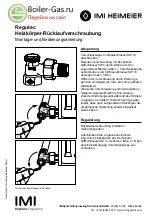
16 Installing the Boiler
2.2 Choosing an Installation Location
When choosing an installation location, you must ensure that the
location provides adequate clearance for the boiler, adequate
venting and drainage options, and sufficient access to gas, water,
and electrical supplies. Carefully consider the following factors
when choosing an installation location:
Compliance Requirements
●
Local, state, provincial, and national codes, laws, regulations, and
ordinances.
●
National Fuel Gas Code, ANSI Z223.1-latest edition.
●
Standard for Controls and Safety Appliances for Automatically
Fired Boilers, ANSI/ASME CSD-1, when required.
●
National Electrical Code.
●
For Canada only: B149.1 Installation Code, CSA C22.1 Canadian
Electrical Code Part 1, CSA-B214-12 Installation code for
hydronic heating systems, and any local codes.
Access to Utilities
●
Water – the installation location should be near where the
domestic water supply enters the building.
●
Gas – the installation location should be near where the gas
supply enters the building.
●
Electricity – the installation location should be near where the
electrical supply enters the building.
Humidity and Contact with Water
When installing the boiler, avoid places with excessive humidity.
The boiler has electric gas ignition components. Moisture can
get inside the boiler and damage the ignition system. The boiler
must be installed in a way to ensure that the gas ignition system
components are protected from water (dripping, spraying, rain,
etc.) during operation and service.
4. Remove the two pallet brackets.
5. Tighten the four screws into the original position.
CAUTION
Ensure that the screws have been retightened so that the
boiler can maintain a proper airtight seal.
Summary of Contents for NFC-175
Page 122: ...Memo...
Page 123: ...Memo...
















































